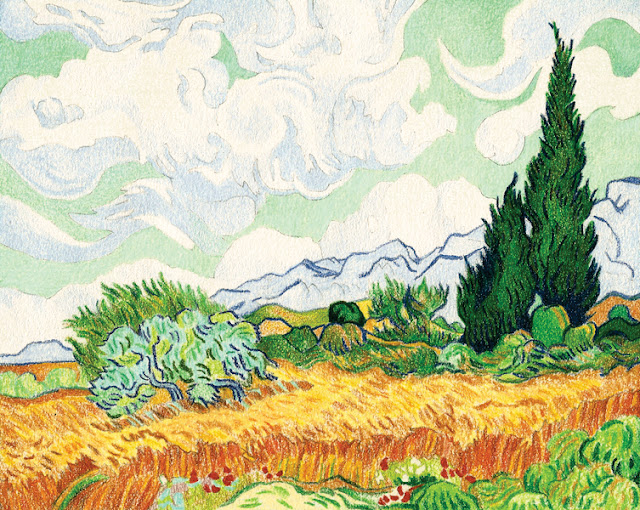Wheat Field with Cypresses - Colored Pencil Drawing
 |
| "Wheat Field with Cypresses after van Gogh" Colored Pencil |
It's a warm, sunny day in southern France. Boiling clouds drift across the turquoise sky and the indigo cypresses are windswept by the notorious mistral. The golden wheat field is ripe and ready for harvest. The picture is a magnificent expression of summer. It draws you in. I can almost feel the wind and the heat. In my head, I can hear the buzz of locusts announcing the change of seasons. This is one of my favorite paintings and I wanted to understand why. I decided to make a study after it but not an oil painting copy. I chose a different medium instead, colored pencil.
"The study I have intended for you depicts a group of cypresses in the corner of a wheat field on a summer's day when the mistral is blowing. It is therefore the note of a certain blackness enveloped in blue moving in great circulating currents of air, and the vermilion of the poppies contrasts with the black note." ~ Vincent van Gogh
Copying the "Old Masters" is an accepted tradition that has occurred throughout the history of art. I've made numerous copies in the past because it's a great way to learn about line, color, composition and technique. Sometimes I even feel like I'm able to get inside the artist's mind and discover the true meaning behind a specific piece of work. Often times I gain greater admiration and respect for the artist I'm making the study after. Vincent van Gogh was the master at taking an ordinary, nondescript scene and turning it into something monumental. Places that other artists would disregard as worthy of paint he turns into masterpieces.
"I have a canvas of cypresses with some ears of wheat, some poppies, a blue sky like a piece of Scotch plaid; the former painted with a thick impasto ... and the wheat field in the sun, which represents the extreme heat, very thick too." ~ Vincent van Gogh
Wheatfield with Cypresses has a balanced composition that is dominated by diagonals which makes it very dynamic. The lines are swirling and broken to express the extreme heat and wind. The two dark cypresses are the focal point, they extend vertically across the horizon line contrasting against the pale green sky. The blue mountains in the background provide some depth and the foreground wheat incorporates some of Vincent's beloved yellow. The analogous color scheme is calming. Yellow, green and blue are right next to each other on the color wheel. There is no violent clash of complementaries, that van Gogh is so famous for, here.
"The tree is as beautiful of line and proportion as an Egyptian obelisk. And the green has a quality of such distinction. It is a splash of black in a sunny landscape, but it is one of the most interesting black notes, and the most difficult to hit off exactly that I can imagine." ~ Vincent van Gogh
One of the most characteristic features of southern France is the cypress tree. In Provence, cypresses are symbols of death associated with cemeteries, but it seems Van Gogh regarded them as a spiritual link to stability in the wild landscape. Within a few weeks after admission into the asylum at Saint Remy, Vincent was allowed to go out into the countryside to paint. He instantly became fascinated with the Provencal cypress trees.
"The cypress is so characteristic of the scenery of Provence; you will feel it and say 'Even the colour is black'. Until now I have not been able to do them as I feel them; the emotions that grip me in front of nature can cause me to lose consciousness, and then following a fortnight during which I cannot work. Nevertheless, before I leave here I feel sure I shall return to the charge and attack the cypresses..." ~ Vincent van Gogh
At Saint Remy Vincent was attracted to nature under stress: huge turbulent clouds, bent trees and rolling hills and ravines. The cypresses seemed to perfectly express his own mood. He saw them as wind tormented shapes that came shooting up out of the unstable ground like whirling black flames reaching for the sun. The cypress paintings were an irresistible release of pent-up emotion bringing out the troubled rhythms he must have felt within. They reveal his style that had evolved - expressive brush strokes, thick impasto and dynamic composition.
"...The cypresses are always occupying my thoughts, I should like to make something of them like the canvases of the sunflowers, because it astonishes me that they have not yet been done as I see them..." ~ Vincent van Gogh
The cypress was as treasured by Vincent as his sunflowers. Like the sunflowers, his treatment of them is exaggerated so that they become extremely vivid and personal. A real cypress does not have such a fiery character or such pointed extremities. Vincent felt that it was he alone who could perceive the true identity of the tree. That is why, today, most artists have such respect for these masterpieces that none would dare try and exceed them.



What exaggerations have you put into your art, Dan, that made it feel distinct to your experience of the source material?
ReplyDeleteHey John, the most obvious distinction is the fact that I used pencils as opposed to paint. Also, my drawing is much smaller compared to the original. Technically, I was more concerned with the lines and I probably worked up the clouds and mountains a bit more. Mostly this was an exercise to learn about color and composition. The thing I love about Vincent is his ability to take a simple, non-descript scene and transform it into a monumental work of art. I got to see a show of his original work in Denver last year and it was awesome!
DeleteI love this drawing! And I like your quotes too from Van Gogh. I'm interested in your process - like did you do this in several days, months, day after day until finished, or take a break, etc.
ReplyDeleteThanks Courtney, this piece is small, 8x10. I can't remember exactly how many hours this one took but it usually takes a couple of months working off and on. I'm kind of slow because I like to build the colors up with several layers and that takes longer. I try to draw every day but that doesn't always happen. Colored pencils work well for me right now because they are convenient. I can start and stop very quickly throughout the day without having to cleanup.
DeleteBeautiful post Dan, great drawing. The simplicity of the scene is what touches our hearts, Van Gogh saw beauty in everywhere.
ReplyDeleteSimplicity is what we should aim in our everyday lifes and be open to look carefully things. Beauty is everywhere.
Thanks, I learned so much from making the study. I agree, some of the most beautiful things are the simplest and they can sometimes be found in your own backyard.
Delete